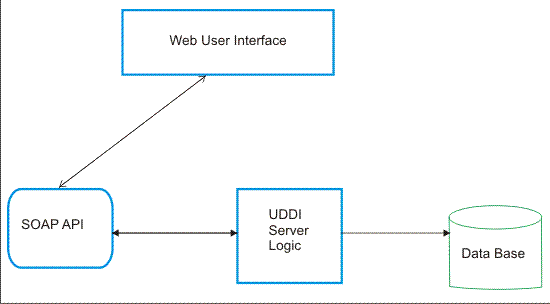| Previous | Home | Next |
Introduction
UDDI (Universal Description, Discovery and Integration) is a directory for storing information about web services to discovering, publishing and finding businesses and integrating business services by using the Internet. It is platform-independent framework for describing services. UDDI communicates via SOAP, CORBA and Java RMI Protocol. UDDI web service interfaces described by WSDL. UDDI is built into the Microsoft .NET platform. UDDI is an open industry initiative enabling businesses to discover each other and define how they interact over the Internet.
UDDI has two parts:
- A registry of all a web service's metadata including a pointer to the WSDL description of a service.
- A set of WSDL port type definitions for manipulating and searching that registry

In September 2000 Microsoft, IBM, and Ariba announced UDDI 1.0. Some time later other companies more than 300 (Dell, Fujitsu, HP, Hitachi, IBM, Intel, Microsoft, Oracle, SAP, and Sun) announced UDDI. May 2001, Microsoft and IBM launched the first UDDI operator sites and turned the UDDI registry live. UDDI 2.0 version announced in June 2001.At this time UDDI is sponsored by OASIS.
Any company can register three types of information into a UDDI registry. These three elements are:
- White pages
- It include basic information which is related to the company and its business
- Business name, address, contact phone number and basic information about company
- To allowed others to discover your web service, a unique identifiers for the company tax IDs is necessary which based upon your business identification
- Yellow pages
- It include more details about the company for example the kind of electronic capabilities the company on this basis company offer to anyone to do business with it
- It accepted the company on there industry type like industry categorization , product codes, business identification codes and industry code which make to easier for companies to search through the listings and find exactly what they want
- Green page
- It include the technical information about a web service that make helps someone to allowed bind customer to the Web service when he has been found
- The various interfaces
- The URL locations
- Discovery information
- To find and run the Web service.
[1] UDDI data model
UDDI includes an XML Schema that describes five data structures:- businessEntity
- businessService
- bindingTemplate
- tModel
- publisherAssertion
[2] UDDI API Specification
A Specification of API for searching and publishing UDDI data. The specifications include:
- UDDI Replication: Its describe the data replication processes and also describe the interfaces. These interfaces are registry operator to conform achieving data replication among sites.
- UDDI Operators: This document outlines the behavior and operational parameters.
- UDDI Programmer's API: This specification inquiring about services hosted in a registry.
- UDDI Data Structures: Specification of XML structures contained within the SOAP messages.

- The Publisher Interface: The Publisher interface defines sixteen operations for a service provider managing its entries in the UDDI registry:
- get_authToken
- discard_authToken
- save_business
- save_service
- save_binding
- save_tModel/li>
- delete_business
- delete_service
- delete_binding
- delete_tModel
- get_registeredInfo
- set_publisherAssertions/li>
- add_publisherAssertions
- delete_publisherAssertions
- get_assertionStatusReport
- get_publisherAssertions
- The Inquiry Interface: The inquiry interface defines ten operations for searching the UDDI registry and retrieving details about specific registrations:
- find_binding
- find_business
- find_ltservice
- find_tModel
- get_bindingDetail
- get_businessDetail
- get_businessDetailExt
- get_serviceDetail
- get_tModelDetail
- find_relatedBusinesses
Java Implementations:
UDDI4J (UDDI for Java)
jUDDI
Perl Implementation:
UDDI::Lite
Ruby Implementation:
UDDI4r
Python Implementation:
UDDI4Py
| Previous | Home | Next |